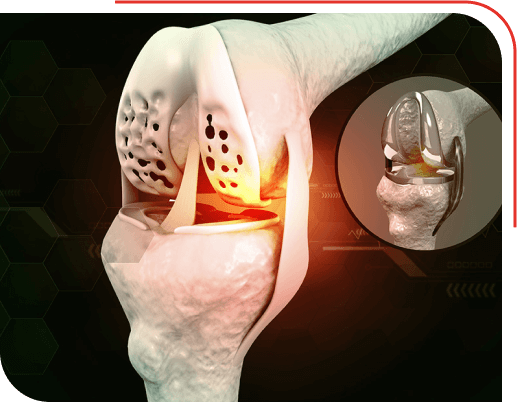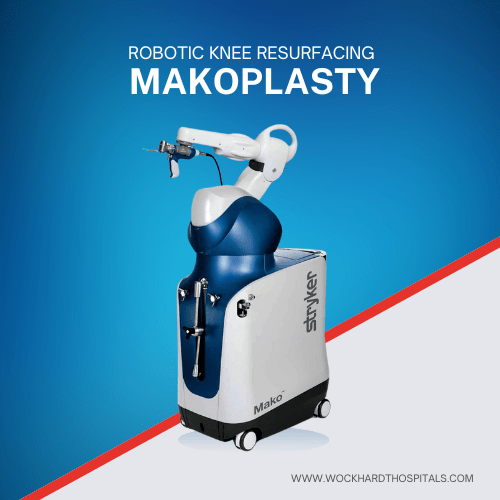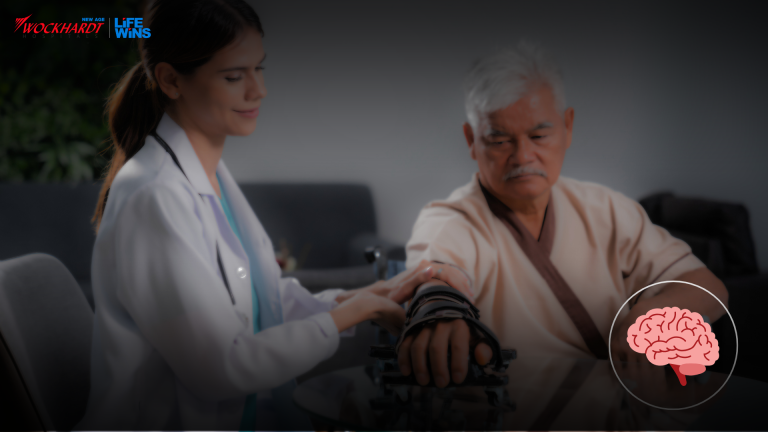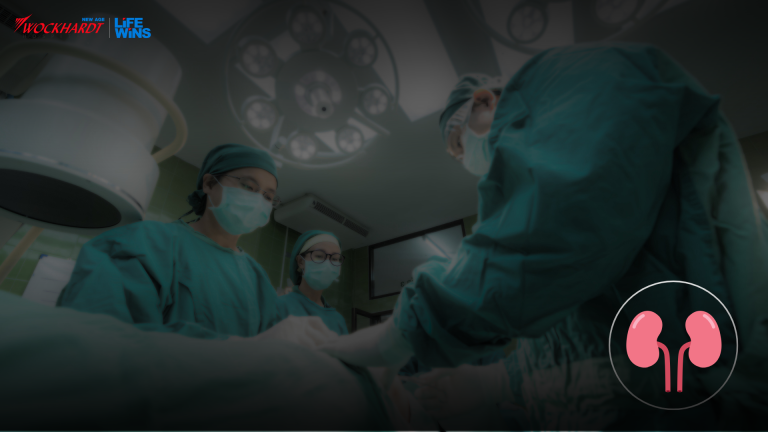Home » Medical Procedure » Total Knee Replacement
Total Knee Replacement
Surgery in India
Total Knee Replacement (TKR)
If your knee is significantly injured due to arthritis or injury, you may find it difficult to do simple activities such as walking or climbing stairs. Even if you are sitting or lying down, you could start experiencing discomfort. You might want to think about having a Total Knee Replacement Surgery (TKR) if nonsurgical options like taking drugs and utilising assistive devices for walking no longer work. To relieve pain, rectify leg deformities, and enable you to get back to your regular activities, knee replacement is a safe and successful technique.

What is Total Knee
Replacement Surgery?
In a TKR procedure, a diseased or injured knee joint is completely removed and replaced with artificial joints (prostheses) composed of metal, plastic, or high-grade polymers. It is an efficient, secure method that may help reduce discomfort and regain function in severely ill knee joints. The procedure is considered the best option for the elderly who are in constant pain. At Wockhardt Hospitals, one of the best hospitals for total knee replacement surgery in India, we have helped thousands of patients get their range of motion and ease their life by eliminating knee pain with successful Replacement. We have accomplished the remarkable success rates of TKR with our most advanced medical techniques, modern and effective tools & equipment used by experienced and top surgeons.
Mako SmartRobotics™ System Assisted Technology for
Total Knee Replacement Surgery
Total knee replacement surgery has witnessed remarkable advancements with the integration of Mako SmartRobotics™ System. With its unique combination of haptic technology and 3D imaging, Mako SmartRobotics™ System Assisted Technology for Total Knee Replacement Surgery offers unmatched precision and patient-specific customisation. With Mako’s software, your orthopaedic surgeon may design your surgery in advance and then use it to guide the Mako SmartRobotics™ System to accurately remove bone and cartilage during the procedure.
How does Mako SmartRobotics™ System Work?
Preparation & Planning
- During the surgery, Mako incorporates haptic technology, offering surgeons real-time tactile feedback during the procedure. As the Mako SmartRobotics™ System interacts with the patient's knee, haptic technology navigation enables surgeons to sense the texture and density of bone and tissue, guiding them in precise bone resection and implant placement.
- The system constantly evaluates the knee's alignment, allowing the surgeon to make real-time adjustments if necessary, ensuring optimal implant placement.
- The surgeon, assisted by the Mako system, precisely removes damaged bone and cartilage, preparing the knee for the new implant.
- Using the predetermined plan, the surgeon accurately positions and secures the implant, aligning it with the patient's anatomy.
Navigation & Precision
- During the surgery, Mako incorporates haptic technology, offering surgeons real-time tactile feedback during the procedure. As the Mako SmartRobotics™ System interacts with the patient's knee, haptic technology navigation enables surgeons to sense the texture and density of bone and tissue, guiding them in precise bone resection and implant placement.
- The system constantly evaluates the knee's alignment, allowing the surgeon to make real-time adjustments if necessary, ensuring optimal implant placement.
- The surgeon, assisted by the Mako system, precisely removes damaged bone and cartilage, preparing the knee for the new implant.
- Using the predetermined plan, the surgeon accurately positions and secures the implant, aligning it with the patient's anatomy.
Improved Functionality & Quicker Rehabilitation
- Following surgery, the surgeon and physical therapist will collaborate with you to establish goals for your recovery and get you back on your feet. Your surgeon may review a postoperative X-ray of your newly constructed knee.
- The precision and accuracy of the surgery result in minimal trauma to the surrounding tissues, promoting faster healing and reduced postoperative pain.
- The precise positioning of the implant may contribute to the longevity of the knee joint, potentially reducing the need for revision surgeries.
- Patients typically experience improved knee functionality and a greater range of motion compared to traditional surgery.
What is Recovery like After Mako SmartRobotics™ System Assisted Surgery?
| Stages of Recovery | Description |
|---|---|
| Post-Operative | Patients are closely monitored for a few hours after surgery to ensure stability and manage pain. |
| Early Recovery | Physical therapy starts early, aiming to regain strength, flexibility, and mobility. Patients gradually increase activity levels under supervision and start engaging in more daily activities with less assistance. |
| Long-Term Recovery | Patients experience significant improvement in mobility and comfort, often returning to normal activities with minimal discomfort. Regular follow-ups ensure continued progress. |
Potential Benefits of Mako SmartRobotics™ System
Mako SmartRobotics™ in Total Knee Surgery
| Benefits | Description |
|---|---|
| Enhanced Precision | Mako technology allows for unparalleled precision in implant placement, optimising alignment and function |
| Personalised Surgical Plan | Customised surgical plans cater to each patient’s unique anatomy, improving outcomes and patient satisfaction |
| Faster Recovery | Reduced trauma and better implant positioning may lead to quicker recovery and potentially longer-lasting results |
Benefits of Total Knee Replacement Surgery
- The crippling knee pain that had rendered you helpless and dependent will be relieved with a replacement.
- If persistent knee inflammation and swelling do not improve with rest, medication, or other therapies such as anti-inflammatory drugs, lubricating injections, physical therapy, or other operations, this surgery may be a suitable alternative.
- Living an active life is likely possible after a knee replacement. You may walk unassisted and move freely to do your daily tasks with the aid of post-surgery recuperation.
- The success rate of knee replacement is relatively high, and the recovery time is short. More than 95% of patients are happy with the outcomes of replacement surgery, and there is no age restriction for the procedure.
- Fifteen years following surgery, more than 90% of patients with a complete knee replacement are still in good health.
Who Should Undergo Surgery For A Total Knee Replacement?
Undergo this surgery if you have one of the following conditions:
- A knee injury or knee arthritis that has severely harmed the joint's mating surfaces.
- Swelling and inflammation do not go away with rest and medication
- If the knee is malformed, such as having an abnormal shape or bloated.
- Pain and stiffness make it difficult to do daily tasks like getting into and out of a car or climbing stairs
Tests Performed Before Surgery
The surgeon at Wockhardt Hospitals will assess your health and other factors to ensure that surgery is the best course of action for you. Here are some things they may evaluate and some tests they may order.
Complete Physical Exam – In a physical examination, the surgeon will look for:
- The state of your ligaments and soft tissues
- A newly formed deformity
- The condition of your neurovascular system
Blood & Urine Test – A urine test can reveal information about the condition of your kidneys and liver. You can discover whether you have anaemia or another blood condition that could compromise surgery with a blood test.
Your orthopaedic surgeon will decide if surgery is the best option to enhance your function and reduce your pain after they have the results of these tests.
Before Procedure
- You will receive a thorough explanation of the procedure from your doctor, who will also allow you to ask any questions you may have.
- Your doctor may do a thorough physical examination in addition to going through a complete medical history and ensuring you are healthy enough to undergo the TKR surgery. You can be subjected to blood testing or other diagnostic exams.
- A dental checkup will be conducted to lower the risk of infection after surgery.
- All prescription, over-the-counter, and herbal supplements you take should be disclosed to your doctor.
- Inform your physician if you are sensitive or allergic to any medications, latex, tape, or anaesthetics (both local and general).
- You should let your surgeon know if you are pregnant or believe that you are pregnant.
- Eight hours of fasting will be required before the surgery, which will usually take place after midnight.
- To assist you in relaxing before the treatment, you could be given a sedative.
- Before your operation, you can discuss recovery with a physical therapist.
- Depending on your medical situation, the doctor could ask you to do anything unique to prepare.
During Procedure
Hospitalisation is needed for total replacement. Depending on your health and your doctor’s preferences, procedures could change. The patient will be given an anaesthetic on the day of the procedure to ensure they don’t feel anything during it. The anaesthesia will either be general or regional. The medical team will choose the type of anaesthesia that is best for the patient.
A procedure to replace a knee can take around 1-2 hours. The surgical team’s duties throughout the procedure are:
- The skin around the surgical site will be cleaned with an antiseptic solution.
- The surgeon will make a cut or an incision near your knee and get rid of any damaged cartilage and bone.
- The surgeon will place the knee implant in the proper location.
- Cement or other adhesives can be used to anchor the implant in place firmly.
- A piece of polyethylene (thermoplastic polymer) will be placed between the metal components of the implant to produce a smooth, gliding surface.
- The surgeon will then suture the incision, and a draining system can be put in the wound to drain fluid from it.
After Procedure
You will then, after the surgery, be taken to a recovery room. The medical staff of the hospital will keep an eye on you for a short while to ensure you come out of anaesthesia without any problems. Additionally, they’ll monitor your pain threshold and vital indicators. You will be transported to your hospital room once your breathing, blood pressure, and pulse have stabilised and you are awake. Having a total replacement surgery often necessitates a few days in the hospital.
People who undergo total replacement rarely leave the hospital on the same day. The length of stay in the hospital might increase if it’s necessary for medical reasons. Soon after your surgery, you will meet with a physical therapist who will create an exercise regimen for you. In the hospital and following release, you will be given an exercise schedule to adhere to
People who undergo total replacement rarely leave the hospital on the same day. The length of stay in the hospital might increase if it’s necessary for medical reasons. Soon after your surgery, you will meet with a physical therapist who will create an exercise regimen for you. In the hospital and following release, you will be given an exercise schedule to adhere to
How to Achieve a Speedy Recovery
After Total Knee Replacement Surgery?
You may take a few crucial steps to make the recuperation process proceed more swiftly and easily:
- Reduce the amount of time you spend standing, and maintain a fully straightened knee joint.
- Your surgeon could provide you with a knee brace following surgery. Wear it.
- It's crucial to follow your doctor's instructions regarding recovery exercises and activities after surgery.
- Your rehabilitation depends on you attending regular physical therapy sessions, medications, and lifestyle choices.
Risks or Possible Complications
With Knee Replacement Surgery
Despite the fact that Knee Arthroplasty is a fairly safe treatment, uncommon problems might happen:
- Blood clots
- Incision site Infection
- Vomiting and Dizziness because of anesthesia
- Injury to the nearby blood vessels or nerves
- Persistent pain
- Implant issues, such as the device loosening or wearing out too quickly
- Blood clot such as Deep Vein Thrombosis (DVT) following surgery
- In the knee, there is scar tissue that can sometimes impair knee mobility
- Reaction to the metal used in the prosthetic knee joint
FAQs
Q. When may I resume my regular activities after having a knee replacement?
You’ll receive detailed instructions from the doctor who treated you. But three to six weeks following surgery, a lot of people may resume their regular routines.
Q. How long is a knee implant supposed to last?
After surgery, most contemporary knee implants endure 15 years or more. With time and regular usage, the plastic implant may start to deteriorate or loosen.
Q. Do I need a blood transfusion before, during, or after the procedure?
This depends on how much hemoglobin you had before the procedure. Blood loss during surgery is often low when using a tourniquet. However, occasionally following surgery, a transfusion might be advised due to the patient’s hemoglobin level and the outflow of the surgical wound’s drain.
Q. How frequently will I visit my surgeon following the operation?
During your hospital stay, your surgeon will manage your treatment. While recovering in the hospital, you’ll probably visit your surgeon multiple times. Two to four weeks following surgery, you will also have a follow-up consultation at the orthopedic clinic.


















